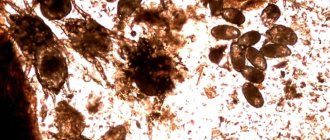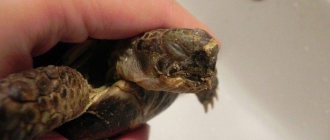Rubella turtle behavior problems and their causes
Turtles may lose their appetite while adapting to new conditions, with the onset of autumn, during the mating season. If none of the options are suitable, it is worth checking the temperature of the contents. It should fluctuate between 26-35 degrees. Otherwise, the animal will be in stressful conditions.
- Do not forget that turtles are cold-blooded creatures that need constant warmth to maintain their vital functions.
Among other things, pay attention to the diet: a young animal can be fed only meat, while the menu of an adult pet consists of 50% meat and 50% plant products (vegetables, fruits).
- Do not forget that turtles are cold-blooded creatures that need constant warmth to maintain their vital functions.
Among other things, pay attention to the diet: a young animal can be fed only meat, while the menu of an adult pet consists of 50% meat and 50% plant products (vegetables, fruits).
Causes of eye diseases
Eye diseases in turtles have different etiopathogenesis and, accordingly, are characterized by different symptoms and clinical manifestations.
The main symptoms of eye diseases in red-eared turtles:
- swelling, edema, sticking of the eyelids;
- redness of the mucous membrane;
- cloudy cornea, presence of a bluish film, white coating on the eyes;
- partial decrease in visual function, loss of vision;
- photophobia, blepharospasm;
- lacrimation;
- abundant mucous, catarrhal-serous, purulent discharge from the eyes;
- inadequate reaction of the pupil to light;
- corneal clouding;
- decreased activity, lethargy;
- deterioration of general condition.
The turtle's eyes are swollen
Other symptoms that indicate the development of ophthalmic diseases in pets include: weakness, decreased appetite, refusal of favorite treats, inappropriate behavior, and lack of response to external stimuli. The turtle stretches its neck forward, takes unnatural poses, and rubs its sore eye with its paws. It hurts and stops opening.
The intensity of clinical manifestations depends on the root cause, the nature of the pathological process, and the stage of the disease.
Eye diseases in red-eared turtles can develop as an independent disease or against the background of viral, bacterial, or parasitic ailments. Decreased immunity, systemic pathologies, and functional disruptions in the body can also cause ophthalmic diseases in turtles.
Eye diseases and eye pathologies often develop due to unbalanced nutrition, feeding turtles with low-quality food, unfavorable conditions and maintenance rules, and lack of proper care. Dirty water, improper arrangement of an aquarium or terrarium, keeping a pet in unsanitary conditions - all this can cause red eyes, swelling or sticking of the eyelids.
Conjunctivitis of various etiologies, swelling of the eyelids occur due to blockage of the channels of the orbital glands, as well as against the background of hypo-, avitaminosis, systemic acquired, congenital pathologies. The cause of eye diseases in red-eared turtles can also be eye injuries of various types, metabolic failures, insufficient lighting levels, sudden changes in temperature conditions, low ambient temperatures, unfavorable indoor microclimate, and poor filtration.
Most often, turtles have swollen eyes and swollen eyelids due to the following diseases:
- conjunctivitis;
- respiratory infections and diseases (rhinitis, pneumonia);
- viral diseases;
- blepharoconjunctivitis.
Regardless of what triggered the development of an ophthalmological disease, it is very important to begin treatment therapy in a timely manner. The treatment regimen and medications will be selected by the attending veterinarian after establishing an accurate diagnosis. You should not self-medicate to avoid causing serious complications.
Conjunctivitis
Eye diseases in turtles
1. Optic neuropathy
Optic neuropathy can be unilateral or affect both eyes. In this case, the eyeball sinks somewhat inward, motionless, the pupil is narrowed, the eyelid is usually closed. In aquatic turtles, this is usually a temporary phenomenon caused by thiaminases in certain types of food. In land turtles, after a long winter, and sometimes when the temperature drops to 0-2 °C in the wintering chamber for only 12-24 hours, temporary or permanent blindness develops.
Symptoms
Lesions can affect one or both eyes. They may include opacification of the lens, opacification of the vitreous, cortical cataracts, disorders of the ultrastructure of the retina, neuritis and atrophy of the optic nerve, paresis of the optic, oculomotor and trochlear nerves, as well as the muscles of the eye innervated by them. In more serious cases, paresis of the facial and trigeminal nerves, paralysis and paresis of the muscles of the neck and forelimbs also develop.
Depending on the depth of the lesion, blindness may be temporary or permanent. If the functions of the muscles of the neck and forelimbs are impaired, the prognosis is unfavorable.
2. Inflammation of the eyelids (blepharoconjunctivitis)
Blockage of the orbital gland canals by desquamated epithelium causes conjunctivitis and swelling of the eyelids. Blepharoconjunctivitis usually occurs due to hypovitaminosis (lack of vitamin A) in the turtle’s body.
Symptoms
Under the lower eyelid, in the conjunctival sac, yellowish cellular material accumulates, resembling pus, but, as a rule, it is not. A swollen nictitating membrane can completely cover the eyeball. Usually, at the first signs of inflammation of the conjunctiva and eyelids, the turtle stops feeding. Wasting from this disease increases the risk of kidney failure.
3. Inflammation of the eyes (conjunctivitis)
Primary bacterial blepharitis or conjunctivitis is not such a rare occurrence. If the turtle does not have other symptoms of hypovitaminosis A (skin flaking, peeling of scales, rhinitis, swelling) or if the symptoms of blepharoconjunctivitis do not disappear after prescribed treatment, then, as a rule, we are talking about primary bacterial blepharoconjunctivitis. In addition, even if blepharoconjunctivitis is primarily caused by hypovitaminosis A, secondary bacterial infection is the most common form of complication.
Sometimes turtles' eyes water from bright light or from sleepiness.
Symptoms
- Absence of other symptoms in the turtle body of hypovitaminosis A
- Swelling of the eyelids, swelling of the nictitating membrane
- Drainage, clumping, or purulent plugs
- Eyelid hyperemia (redness of the eyelids)
4. Eye diseases (uveitis and panophthalmitis)
Inflammatory processes can also affect various tissues of the eye, such as the eyeball, cornea, sclera, retina, etc. The most common diseases in turtles are uveitis (the anterior chamber of the uveal tract) and panophthalmitis (all tissues and membranes of the eye).
5. Uveitis
The process is almost always bilateral and develops secondary to septic pneumonia, other forms of sepsis, or after sudden cooling. The eye retains its integrity, but cellular inflammatory material and yellowish-white pus accumulate in the lower sector of the eye. As a rule, general symptoms are present: exhaustion, rhinitis, lethargy, the turtle does not feed (as with any disease that impairs vision).
In the vast majority of cases, the disease develops after wintering or when kept without heating for a long time. Aquatic turtles are most often affected. The disease develops due to the penetration of pathogenic bacteria from the oral cavity through the lacrimal canal into the subcorneal space.
6. Panophthalmitis
Symptoms
Corneal opacities that cannot be removed mechanically and pericorneal injection of the eyeball vessels. The presence of blood in the eye indicates traumatic symptoms.
If your turtle is behaving strangely and you think it is sick, look to see if it has any symptoms of disease; if so, try to immediately contact a veterinarian to examine and treat the reptile. It is better to prevent the disease than to try to pull the turtle out of the dead at a critical stage of the disease. If you are not confident in your knowledge and skills, do not try to treat the turtle yourself, with the exception of the simplest actions, such as lubricating scratches or medicinal baths.
If your turtle is behaving strangely and has the symptoms described above, do not self-medicate. Entrust this matter to a veterinarian - herpetologist.
What should an owner do if a red-eared turtle does not open its eyes?
If discharge appears from the eyes or they become covered with a film, then immediately show your pet to a veterinarian. Do not treat your reptile yourself with ointments or eye drops, much less give any injections!
If your eyes are simply closed, then watch the reptile. Carefully analyze the conditions of its detention. Diversify your diet by including enough fish, shellfish, and meat. Install an ultraviolet lamp if one is missing. Check the water temperature, it should be between 27-31 degrees.
If the conditions are correct, but the turtle does not open its eyes or it does not look the same as usual, show the reptile to a herpetologist. He will make the correct diagnosis and give qualified recommendations for treating the health of your pets!
Even if the conditions are close to ideal for a turtle, it can still get sick. In this case, there may be inflamed eyelids. They become inflamed due to conjunctivitis, pneumonia or rhinitis. It is recommended that the examination be carried out by a specialist, although not everywhere there are doctors who are able to diagnose turtles and identify the true reason why the reptile’s eyes do not open.
Sometimes it happens that after expensive treatment, a pet does not recover, but becomes even more ill. This is caused by the use of drugs against turtle disease that are used inappropriately. In other words, the drugs are intended for cats and other pets.
So, the main reasons why the red-eared turtle does not open its eyes are:
- Sleep or hibernation. Depending on the conditions, it can be for 2-3 months. If there are no obvious signs of illness in your eyes, then you don’t have to worry and wait for your pet to wake up.
- If there is a white hymen in the eyes, then the cause is improper content or lack of UV radiation.
- If the eyelids are swollen and red, it means your pet has a cold or other infectious disease. This reason is the worst for reptiles.
We suggest you read: How to stop a cat from scratching furniture and wallpaper: 7 ways
If the red-eared turtle does not open its eyes, or its appearance and behavior alarms you, a number of different factors may be responsible for this. The first is vitamin A hypovitaminosis. Its deficiency manifests itself with an unbalanced diet and the lack of a sufficient amount of plant food. Another reason is unsanitary conditions in the aquaterrarium.
- Avoid vitamin A deficiency. This means including fresh greens and other vitamin-rich foods in your diet. Many owners of reptiles mistakenly believe that food purchased at a pet store will fully satisfy their pets’ needs for nutrients and multivitamins. In fact, this is not true.
The diet should be carefully thought out, and natural products should be its main component.
- Take vitamin supplements. You will achieve maximum results from their use by first consulting with your veterinarian. He will tell you which manufacturer to give preference to, what is the optimal dosage and course duration. But keep in mind: if you follow a diet that includes foods rich in vitamins and minerals, the use of supplements is not necessary.
- And, of course, to prevent infections, always keep the aquaterrarium water clean. Many reptile owners resort to special filters. Their installation will purify water from ammonia and nitrites. These substances irritate the sensitive tissues of the eye, which ultimately leads to the development of diseases. To assess the performance of the filter, you can purchase a set of indicators at the pet store that determine the level of ammonia and nitrites in the water. As a result of the inspection, they must show their absence. Otherwise, the filter you purchased is not effective.
Why doesn't the turtle eat anything?
Refusal to eat can be the result of a variety of reasons. Some species are sensitive to temperature changes, others do not eat the food offered, sometimes this is a process of adaptation or behavior patterns at different periods of the year.
- When an exotic pet appears in the house, the process of feeding it is exciting and you want to pamper it with different delicacies. However, the first and most common reason why a turtle does not eat is overfeeding. The young eat little by little every day, and the adult eats enough in just three meals a week. By observing the turtle, you can determine its portions and taste preferences, because you won’t be able to force feed it.
- If there are several individuals in the aquarium, the male turtle does not eat due to the desire to reproduce. Pets simply do not want to waste time and energy on food. After mating, everything will return to normal and the appetite will resume.
- When a turtle does not want to eat and does not open its eyes, it should be taken to a specialist. A common cause of illness is low temperature and improper care. This issue can only be resolved after consultation.
Why don't turtles eat in winter?
With the arrival of autumn cold weather, many species begin to prepare for hibernation. There are several important points in this matter.
- The idea of wintering is to sleep in a cool, damp place before the temperature starts to rise. If there is food left in the stomach, after waking up the death of the turtle is inevitable; at best, it will wake up sick and long-term treatment will begin.
- Therefore, it is difficult to ensure the correct hibernation regime at home. But nature itself suggests giving up food and switching to low energy expenditure. The red-eared turtle does not eat in winter for the same reason: it is gradually preparing for suspended animation.
- To prevent hibernation, you should increase the temperature and install a UV lamp.
Why doesn't the red-eared slider eat anything?
This species is capricious and picky in matters of home maintenance. Long before purchasing, you should learn more about the basic rules of content in order to avoid common mistakes.
- As the temperature in the apartment drops, the red-eared turtle becomes lethargic and does not eat. These are the first signs of preparation for winter sleep. Hibernation over the winter should not be allowed at home. You should increase the temperature in the house and install a lamp.
- If the turtle does not eat, but the activity remains the same, you have acquired a male and he is showing sexual activity. This is typical when keeping several turtles in an aquarium. After the mating season, the red-eared turtle will eat in the same portions.
- It makes sense to observe the situation in an aquarium where several individuals are kept. Sometimes the larger ones begin to dominate and simply take food away from the other cohabitants.
- Red-eared turtles require a constant temperature of about 30°C. This is the main condition for maintaining vital processes, this also applies to the reptile’s appetite.
- We must not forget about the peculiarities of feeding. A young red-eared turtle eats only meat; for adults, half of the diet consists of food of plant origin.
The land turtle does not eat
Inexperienced owners of land turtles often do not fully understand the importance of observing the conditions of keeping the reptiles. The Central Asian species does not claim a lot of attention; the reptiles are truly unpretentious. However, every beginner faces the problem of lack of appetite. If the already listed general answers to the question why the turtle does not eat do not fit the description, the land pet is probably refusing food due to another reason.
- The place of purchase is of great importance. Buying from someone unknown increases the likelihood of bringing home a sick animal significantly. The first thing you should check is the lower part of the shell and the mouth and neck for yellow spots and flakes.
- Delivering a pet home is another challenge for the owner. Refusal to eat at first is a consequence of adaptation. However, on the way home the turtle could have caught a cold. For the same reason, experts strictly do not recommend allowing a turtle to roam freely around the apartment.
- Find out what your pet was fed before the sale. The turtle eats familiar food more readily in new conditions.
Why doesn't the turtle eat food?
When it comes to feeding, any extreme can cause irreparable harm to the pet’s health. Therefore, a combination of dry store-bought food and natural food is considered the optimal solution. If your turtle doesn't eat a certain food, this may be a sign that it needs to change its diet.
- Every pet has its own taste preferences. It is likely that you did not like the proposed brand of food. Sometimes the composition causes constipation or indigestion, causing the turtle to ignore the pellets and not eat.
- If you offer only natural food, the body will spend more energy on digestion, but will receive fewer minerals and vitamins. A diet of only dry food will compensate for the lack of microelements, but will worsen digestion. You will have to use trial and error to find out why the turtle is not willing to eat, but rely on the promises of the manufacturers. The breeder’s task is to find the optimal ratio of natural and granulated food.
The turtle does not open its eyes and does not eat
After the winter period, the pet should return to activity and its previous appetite. If this does not happen on the fifth or sixth day, you should consult a specialist. An alarm signal is the turtle's constantly closed eyes.
- An obvious reason why a turtle is not eating may be a lack of vitamin D. A UV lamp will help replenish its deficiency. Closed eyes, lethargy and refusal to eat are the first symptoms of rickets or metabolic disorders. The turtle should take sunbathing under a lamp for about 12 hours a day; in addition, vitamins and medications must be introduced into the diet to restore the body after wintering.
- The picture when a turtle does not eat anything, and its eyes are closed and signs of conjunctivitis are already visible, is characteristic of a lack of vitamin A. The fact is that vision in reptiles plays a vital role for nutrition, therefore inflammation of the eyelids will certainly lead to a refusal to eat. Washing, injections and other procedures will be prescribed by a specialist; in this case, self-medication poses a real threat to the life of the turtle.
The turtle does not eat and constantly sleeps
Wintering in apartment conditions without hibernation presupposes a low-active lifestyle, but this period is confined to a very specific time frame. Large adult individuals hibernate for 12-14 weeks, young animals for 8-10. If on the fifth day after the supposed end of hibernation the turtle does not begin to return to its previous rhythm, this is a sign of disturbances in the body.
- The appetite will return gradually; there is no point in expecting sudden active eating of your favorite food. Spring anorexia, when about 40% of weight is lost during the winter without food, is considered normal. Warming up under a lamp will return your pet to an active life.
- The obvious reason why a turtle does not eat and sleeps constantly may be dehydration and exhaustion of the body. If before the hibernation period the animal did not have time to empty its stomach, there is a possibility of kidney or liver failure due to improper wintering.
The turtle does not eat and does not swim
Proper living conditions are relatively easy to maintain; this is the key to the health and life of your pet. Letting it walk on the floor or carpet, not checking the temperature of the water and air, forgetting about the gradual decrease or increase in temperature with the change of season - all this is a direct path to the development of pneumonia in a turtle. If an aquatic turtle does not eat and immediately falls over on its side in the water, these are symptoms of pneumonia. Injections, warming under a lamp, increasing the temperature and warm steam baths will help here. All this is prescribed by a specialist.
Little turtle doesn't eat anything
For young animals, typical reasons for refusing food are adaptation after a change in living conditions and improper care. To avoid health problems when your baby turtle doesn't eat, you should follow the advice of experienced breeders.
- Purchase a reptile only from a trusted pet store.
- Deliver it home as quickly as possible, and try not to catch a cold.
- Provide the home with all the necessary living conditions and give it a week to adapt. Only after five to seven days can food be offered.
WHAT TO DO IF YOUR EYES ARE CLOSED?
If your turtle suddenly stops behaving as before and spends all the time with his eyes closed, you need to start observing him to understand the cause of the symptom and take action.
The disease is not as terrible as the lack of treatment or a late reaction to the symptoms - most turtle owners wait until the last minute for everything to go away on its own. This should not be done under any circumstances - the turtle cannot control its condition and say when it feels bad, and diseases usually develop very quickly.
The first thing to do is to make sure that the turtle is kept in good conditions. Perhaps the temperature has dropped and the animal is trying to hibernate, or the water is too dirty and microbes are multiplying in it. In any case, after the errors identified in care are eliminated, the disease can slow down significantly.
It is necessary to carefully observe your sick pet - how it moves, how it breathes, whether it eats, how much it sits on land and how much time it spends in the water. Observations will help you find out the cause of closed eyes, however, you should not extend this period for a long time - it is optimal to watch your pet’s behavior for about a day in order to begin treatment the next day.
How to treat the eyes of red-eared turtles?
What to do if your red-eared slider's eyes are swollen? This question interests many breeders who care about the life of their beloved pet. Treatment of turtles if their eyes, eyelids are swollen, or any other ophthalmological ailment is diagnosed, is prescribed by a veterinarian. It is very important to establish what caused the eye disease in your pet, normalize its general condition, restore visual acuity and visual function if it is impaired.
Important! As a rule, therapeutic therapy involves complex treatment using general medications and drugs for local treatment (drops, ointments, liniments).
If a turtle's eyes are swollen and cannot open, or the eyelids are inflamed due to conjunctivitis, the root cause must first be determined. Be sure to move your pet to a new aquarium and create optimal living conditions. Change the water in the turtle's usual habitat.
Antibacterial drops, anti-inflammatory, and general restoratives are used in treatment. The following medications can be prescribed to your pet: Albucid, Sofradex, Tsiprolet, Tsiprovet, Floxal. Drops are applied to the eyes 2–3 times a day for 5–7 days.
If your tortoise cannot open its eyes on its own, gently pull down your pet's lower eyelid before adding drops. Before carrying out the procedure, use a sterile gauze-cotton swab to wipe the eyes from dirt, remove dry crusts using physiological solutions, antiseptics (Ringer-Locke solution).
Important! Drops should be instilled into each eye, even if the eyelids are swollen and inflamed on one. Use a separate cotton pad for each eye. Carry out all manipulations very carefully. To prevent the pet from pulling its head into its shell, secure the turtle well and hold it at the base of the neck. Enlist the help of an assistant.
If the eye disease is caused by viruses, the turtle is given an intramuscular injection
If a turtle's eyes are swollen, the treatment course can range from 5 days to 2 weeks. Treatment of the disease is continued until the condition is completely normalized.
If the turtle constantly rubs its eyes or scratches its eyelids, use Hydrocortisone ointment and drops containing corticosteroids are instilled into each eye. Treatment takes about 5–6 days. After eye drops, do not place your pet in water for 15–20 minutes.
In the absence of positive dynamics, if medicinal, conservative treatment does not produce results, the condition of the red-eared turtle worsens, a surgical operation will be prescribed, which is performed under anesthesia in a hospital setting.
Treatment for inflammation of the eyes and eyelids can be supplemented with complex vitamin preparations, immunomodulators, and mineral supplements. In severe cases, you can pierce your pet intramuscularly with a prescribed vitamin preparation. Dosage - 0.6 mg/kg. It is permissible to give a second injection after 12–14 days.
If there are no contraindications, the eyes are open, but the eyelids are edematous and swollen; in combination with drug treatment, heating with a UV lamp helps a lot. Since red-eared turtles may not be able to withstand 5-6 hours of warming up, arrange shelters for your pet. Place a bath of warm water in the aquarium.
We invite you to read: Siamese cat - description of the breed and character of the photo...
Tsiprovet (eye drops) is used for swelling of the eyes in turtles
To ensure your pet’s treatment is successful, follow all recommendations of your attending physician. Stick to the dosages indicated in the medication label.
During treatment, enrich your diet with plant foods and fresh herbs. Give your turtle raw beef liver, carrots, which are a source of vitamin A, young cabbage, squid, pond algae, and lettuce. Your pet's food should be healthy, fortified and balanced. Young turtles should be fed at the same time every day. Adult red-eared turtles after three years of age need to be fed no more than three times a week.
How are eye diseases treated in turtles?
- If there are traces of purulent or cheesy nitrous oxide, then you need to rinse your eyelids. To do this, use either a regular syringe without a needle or a catheter. Washing is carried out with Ringer's saline solution (it can be obtained from both human and veterinary pharmacies).
- Vitamin injections are given. That is, if a land turtle has swollen eyes, then a vitamin cocktail in ampoules is used (can be obtained at any veterinary pharmacy). One injection will be enough, you can repeat the procedure in a few weeks.
- Ciprovet drops are instilled under the lower eyelid (can be obtained at any veterinary pharmacy).
- If the turtle scratches its swollen eyes, then you need to smear the eyelids with Hydrocortisone ointment. The product is used at night.
Read other questions on the topic: A turtle laid an egg, what should I do?
What is important to consider
First of all, make sure that the pet is simply not sleeping, because the good vision of the red-eared turtle allows it to stay awake both during the day and at night. Observe her throughout the day. Too much sleep and general lethargy can be warning signs of illness, even if the reptile's eyes are still shiny and wide open. In this case, immediately adjust the conditions of detention. So, the disease can be provoked by:
- Low water temperature;
- Lack or insufficient use of UV lamps and shore heating;
- Unbalanced diet;
- Poor filtration and irregular bottom cleaning.
If, after all the conditions have been corrected, the red-eared turtle does not open its eyes within 6 hours, sound the alarm. This means that the disease already exists. It remains to be found out what kind of illness struck the pet. To do this, observe the ward for another day. By the way, during this time be sure to stock up on:
- Container for quarantine;
- Pharmaceutical chamomile;
- Methylene blue;
- With cotton swabs.
Other medications may also be needed, but this will be discussed later - when the cause of the problem is found out. Let's start with the most common eye diseases of reptiles in aquaterrariums.
Common conjunctivitis
A sure sign of this sore is inflammation of one eye. If the disease starts, both will swell and close, and the mucous membranes will turn dark red. A red-eared turtle can “catch” this eye disease due to insufficient clean water. For treatment you will need:
- Place the turtle in any dry container and completely disinfect the aquaterrarium.
- Wash your pet with warm running water and pat dry thoroughly but gently with a simple cotton or linen towel.
- In the morning, at lunch and in the evening, drip sodium sulfacyl (aka albucid) into the eyes; in severe cases, a special tetracycline ointment in a small tube will not hurt.
Treatment of this disease will take about a day, but if the disease is advanced, it will take more time. Before placing an already healthy pet in an aquaterrarium, add a few drops of methylene blue previously diluted in a small amount of water to the water. By the way, this must be taken as a rule in other, more severe cases.
DISEASES AND TREATMENT
Conjunctivitis
Signs
- one or both eyes close and swell, the mucous membrane may turn purple.
Treatment begins with transplanting the turtle from the aquarium into a separate basin without water. Conjunctivitis is often caused by bacteria and germs getting into the eyes.
It is necessary to drip sodium sulfacyl (albucid) into the eyes several times a day, preventing the turtle from retracting its head and avoiding treatment. Tetracycline ointment is also applied to the eyes. If the turtle's eyes fester, you need to carefully remove the pus with a blunt object, such as a toothpick or a cotton swab.
A sick pet will benefit from warm (warmer than regular aquarium water) baths with freshly brewed chamomile.
The aquarium needs to be washed and cleaned
to get rid of germs and add new water. For final disinfection, it is advisable to drop a few drops of Mythelen blue into the water. You can return the turtle to the aquarium only after complete recovery.
Pneumonia
Closed eyes often accompany a turtle's cold.
Signs
- lethargy of the pet, poor appetite, the turtle floats on the surface of the water and does not drown, but at the same time does not make any movements and seems to float, often cannot dive. May “cough” – make strange sounds with the mouth while sitting on land.
Treatment can be divided into medical and traditional methods.
In the first case, an examination by a veterinarian is required. The turtle will need to be weighed, and based on the weight (excluding the shell), intramuscular injections of the prescribed medication will be given. The difficulty of treatment lies in calculating the correct dose, since the slightest overdose leads to the death of the animal.
The traditional method of treatment does not pose any dangers, and in non-advanced stages of the disease it is very effective.
The turtle must be removed from the aquarium into a dry container. The room in which it is located must be warm, with dry air, without drafts.
The main medicine in this case is chamomile.
. A strong decoction is brewed and two types of procedures are performed on the turtle - “inhalation” and bathing.
Inhalation is aimed at warming the lungs. You need to boil water in a saucepan, brew chamomile in it, and then carry out actions similar to regular cold inhalations. It is best to sit on the bed and place a stool next to it, with a pan of boiling water on it.
To concentrate the heat and prevent the heated air from dissipating throughout the room, you need to cover yourself with a blanket. You can hold the turtle in your hands, but it is even more effective to hold it directly above the pan, without burning it, at a distance of ten centimeters. To avoid the risk of dropping your pet into boiling water, you can place it in a sieve and cover it with something on top, even your palm, and prevent it from getting out.
During this procedure, the turtle breathes a hot chamomile infusion, which is very useful for inflamed lungs.
Bathing is done in the same chamomile decoction, cooled or diluted. The temperature of the broth should be higher than usual for the turtle, but not burn. The turtle should be left in the broth for about 20 minutes, after which it should be placed back in a basin without water.
Sore eyes with pneumonia must be treated in the same way as with conjunctivitis - by instilling albucid into the eyes and applying tetracycline ointment. Chamomile will also treat sore eyes - as an antibacterial agent.
Frequent pneumonia
If a red-eared turtle coughs, eats poorly, swims sideways, cannot dive and does not open its eyes, it is a 100% cold. The sore is not uncommon, unpleasant, but at the initial stage it is curable even at home. In this case, warm baths and inhalations with chamomile are effective. What does that require:
- Brew a strong decoction of a medicinal plant in a deep saucepan and inhale it as for a person. Your own nasopharynx will be an excellent indicator of temperature. As an option, a hand in which you can hold a suspended turtle is also suitable. The procedure will take at least 10 minutes, so if it’s hard to hold your hand suspended for so long, use a sieve, but not a metal colander. Otherwise, the pet will get burns.
- Upon completion of the inhalation, dilute the chamomile infusion with water to a temperature of 40-45ºC and give your client a bath. It is important that the temperature does not drop below 30ºС. It’s good if a sick pet splashes around in the healing infusion for at least 20-25 minutes.
- Then you need to warm the reptile for four hours in a dry container at a temperature not lower than 35ºC.
Such procedures need to be repeated a couple of times a day until the reptile recovers. Typically, the process takes about a week. But there are also more complex diseases that require a special approach.
The turtle's eyes are closed
Constantly closed eyes of a reptile are an alarming signal. The reasons may be that the pet does not receive enough ultraviolet radiation. UV light is important for the turtle’s body to produce vitamin D. Otherwise, hypovitaminosis, rickets develops, and metabolism is disrupted. As a result, the reptile becomes lethargic, refuses food, its eyes swell and it keeps them closed. How to help a turtle:
- Install a UV lamp. It is recommended to use Repti Glo. For a land reptile, you need an 8.0 or 10.0 lamp. An adequate substitute with a UV-B value of 8 - 10% is also suitable.
- The lamp must be on 12 hours a day.
- Give ReptoCal and Reptolife with food. They need to be mixed in a ratio of 3 to 1. Dilute the mixture of powders in the bottom of a teaspoon with a small amount of water and inject it into a piece of food. This “medicinal” food should be given with each feeding. If your pet is not yet eating, force the mixture into his mouth once a day, and when he begins to feed on his own, switch to “enriched” food as indicated above.
- Give reptiles baths with chamomile infusion. The duration of the procedure is half an hour. The bath temperature should be from 26 to 30 degrees. Please be present during the procedure and make sure that the turtle does not drown.
Sometimes the turtle not only has closed eyes, but also swollen eyelids and inflamed conjunctiva. Most often this occurs due to a lack of vitamin A. Under the lower eyelid you may notice a discharge similar to pus. In turtles, vision plays an important role when feeding. If such an inflammatory process develops, the reptile refuses to eat. How to help:
- Make two injections of the Eleovit vitamin complex. There is a 2 week pause between injections. Dose - 0.6 ml per kilogram of reptile weight.
- Rinse eyes twice a day. Use warm saline solution for this. Chamomile decoction also gives good results.
- After washing the eyes, you need to instill Sofradex drops. The course of drops lasts no more than five days. You can also drip with the drugs “Alucid”, “Tsipromed”.
- If the eyelids are severely inflamed and reddened, an ointment - tetracycline or gentamicin - should be applied to them.
- While the reptile is not eating, you can support its body with five percent subcutaneous injections of ringer and glucose.
Best regards, Galina.
Constantly closed eyes of a reptile are an alarming signal.
The reasons may be that the pet does not receive enough ultraviolet radiation.
UV light is important for the turtle’s body to produce vitamin D. Otherwise, hypovitaminosis, rickets develops, and metabolism is disrupted.
As a result, the reptile becomes lethargic, refuses food, its eyes swell and it keeps them closed. How to help a turtle:
- Install a UV lamp. It is recommended to use Repti Glo. For a land reptile, you need an 8.0 or 10.0 lamp. An adequate substitute with a UV-B value of 8 - 10% is also suitable.
- The lamp must be on 12 hours a day.
- Give ReptoCal and Reptolife with food. They need to be mixed in a ratio of 3 to 1. Dilute the mixture of powders in the bottom of a teaspoon with a small amount of water and inject it into a piece of food. This “medicinal” food should be given with each feeding. If your pet is not yet eating, force the mixture into his mouth once a day, and when he begins to feed on his own, switch to “enriched” food as indicated above.
- Give reptiles baths with chamomile infusion. The duration of the procedure is half an hour. The bath temperature should be from 26 to 30 degrees. Please be present during the procedure and make sure that the turtle does not drown.
Sometimes the turtle not only has closed eyes, but also swollen eyelids and inflamed conjunctiva. Most often this occurs due to a lack of vitamin A. Under the lower eyelid you may notice a discharge similar to pus. In turtles, vision plays an important role when feeding. If such an inflammatory process develops, the reptile refuses to eat. How to help:
- Make two injections of the Eleovit vitamin complex. There is a 2 week pause between injections. Dose - 0.6 ml per kilogram of reptile weight.
- Rinse eyes twice a day. Use warm saline solution for this. Chamomile decoction also gives good results.
- After washing the eyes, you need to instill Sofradex drops. The course of drops lasts no more than five days. You can also drip with the drugs “Alucid”, “Tsipromed”.
- If the eyelids are severely inflamed and reddened, an ointment - tetracycline or gentamicin - should be applied to them.
- While the reptile is not eating, you can support its body with five percent subcutaneous injections of ringer and glucose.
Fortunately, these symptoms are not uncommon, and there are known treatments that can help your turtle.
You will need chamomile decoction (brew 4-5 tablespoons in a saucepan). Add it to a full bath of water (38-45 °C), put your “patient” in there and let him swim until the water cools down. It is especially important to keep the turtle in the medicinal water for as long as possible the first time. After this, warm your pet in a dry container under two incandescent lamps and UV for 6 hours. The first step towards recovery has been taken.
Bathing in chamomile decoction must be repeated a couple of times a day, the duration of each should be 30 minutes. Warming up must also be repeated - 4-6 hours every day. However, the container should not be too hot - also leave a shelter for the turtle (coconut shell, crock, under which you can hide from overheating).
Pets such as red-eared turtles have long ceased to be exotic. Most believe that keeping them is not a troublesome process, since these animals are completely unpretentious and can eat any fruit.
This is not entirely true: improper handling of red-eared turtles and poor conditions can lead to dire consequences. The pet may get sick and become less active. What symptoms should cause concern, what to do after they appear?
Complex rhinitis
Many novice breeders often wonder what to do if a red-eared turtle sneezes, scratches its eyes, blows its nose, and at the same time has difficulty swimming. In this case, it won’t hurt to take a close look at the nostrils and inner corners of your pet’s eyes - they are inflamed with rhinitis. Further treatment depends on the causes of rhinitis:
- Polluted water. In this case, you cannot avoid a procedure that is unpleasant for the reptile and time-consuming for the owner - to rinse the turtle’s nasal passages with an antiseptic liquid using a syringe without a needle. A weak solution of furatsilin or chamomile at a comfortable temperature is suitable as an antiseptic.
- Another cause of a runny nose in a reptile may be improper feeding and, as a result, a lack of vitamin A. In this case, intramuscular injections of the vitamin or increased feeding with food containing it are recommended.
- Rhinitis and swelling of the eyes also occurs with hypothermia.
Clinical signs of rhinitis are similar to pneumonia. It can be distinguished from the latter by its constantly slightly open mouth and the bubbles that form at the nostrils when breathing. In especially severe cases, an infectious runny nose is treated with antibiotics, for example, Baytrill. But it is difficult to calculate the dosage, since it is necessary to take into account the weight of the pet without a shell.
It is much more convenient to use a special aerosol, which can be purchased at a regular pharmacy or pet store, after consulting with the seller. Medicines intended for children are best. Otherwise, the treatment of rhinitis is carried out in the same way as pneumonia.
We suggest you read: What to do if your cat is choking
Treatment of inflamed eyes of a red-eared turtle is impossible without instilling eye drops, applying ointment and removing pus with a cotton swab. However, the reptile will not quietly tolerate such procedures - it strives to bite or hide its head in its shell. You can make the task easier like this:
- Prepare the necessary medications in advance - open the jar or tube and place a cotton swab next to it.
- With your left hand, quickly, so that the pet does not have time to retract its head, grab it from below and from behind. Using your thumb and forefinger, gently but firmly secure the neck at the base of the shell.
- Perform therapeutic manipulations with your free right hand.
A long six-hour warm-up in a dry aquarium can be tiring for a sick reptile. A shelter made from natural materials will help her feel more comfortable. For example, half a clay pot split lengthwise. It is also recommended to put a bath of warm water for her.
When choosing a container for warming up, avoid plastic basins - they release dangerous toxins and the person under your care can be poisoned. It is also important to remember about access to fresh air. By the way, you cannot use a plastic mesh instead of a lid for the same reason as a basin of dubious quality. The ideal option would be regular gauze with small ventilation holes and a glass aquarium.
Even in the warm season, the red-eared turtle is sensitive to drafts. Therefore, before carrying out treatment procedures, do not forget to tightly close the windows and interior doors. If all the rules are followed, the pet will quickly recover and will again delight its owner.
Eye diseases of red-eared turtles and their symptoms
The following symptoms may indicate eye disease in a turtle:
- Redness of the mucous membrane of the eyes.
- Swollen eyelids.
- The appearance of a white coating on the eyeballs.
- The turtle is unable to open his eyes.
- Cloudiness of the cornea.
- Slow reaction of the eyeball to current events.
The above symptoms may be accompanied by general weakness, poor appetite, high fever, and impaired coordination of movements.
Such symptoms indicate the presence of an eye disease such as conjunctivitis. It is caused by bacteria staphylococci and streptococci.
This serious illness can be caused by poor diet or unsanitary conditions. If the water in the aquarium has not been changed for a long time, then the red-eared slider’s eyes will first of all become swollen, which will indicate that the water is polluted.
Another serious turtle eye disease is panophthalmitis. This disease is caused by a purulent infection that affects the tissue of the eyeball. Evidence of such a disease can be clouding of the eyeball, and if appropriate treatment is not started immediately, the turtle may lose its vision.
Treatment of eye diseases of the red-eared turtle
At the first appearance of symptoms, the animal should be immediately placed in clean water, since it is contaminated water that leads to eye diseases. Since the causative agents are infections, antibiotics and drops are used for treatment.
For medicinal treatment it is possible to use the following pharmaceutical products:
- These can be “Sofradex”, “Tseirolet”, “Albucid”, “Topradex”, which are instilled into the eyes twice a day. If the turtle is unable to open its eyes, then carefully pull back the lower eyelid and apply eye drops. The course of treatment can last from 5 to 10 days, depending on the degree of damage.
- A disease such as panophthalmitis can only be treated with antibiotics and only under the supervision of a veterinarian. Self-treatment is not advisable, as it can lead to the death of the animal.
- If the disease is advanced, there is a high probability that the eyeball will be removed.
- In the process of treating turtle eye disease, it is advisable to enhance the effect by using multivitamins, such as “Intravit”, “Multivit”, “Eleovit”. Since vitamin D2 is poisonous for turtles, you should always pay attention to the content of the corresponding vitamins in the preparations. At the same time, vitamins can be administered by injection, if, of course, the doctor does not mind.
- To alleviate the suffering of the red-eared turtle, it is possible to use chamomile decoction and a solution of boric acid. They moisten swabs and remove plaque from the turtle's eyes.
- At the very beginning of the appearance of signs of the disease, tetracycline ointment can help.
Nutrition of red-eared turtles for eye disease
In case of eye damage, it is very important to provide the turtle with proper nutrition. A turtle's diet should include foods rich in vitamin A. As far as we know, vitamin A is good for vision, and not just for turtles. Carrots are rich in this vitamin. The basis of the turtle's food is seafood, but if there is an eye disease, you can give it livers once a week, and also focus on food of plant origin, such as cabbage, seaweed, lettuce, and seaweed. As a rule, such foods are rich in vitamins.
If your pet is seriously ill and cannot open its eyes, it will be difficult for him to find food in the aquarium. In this case, the owner himself will need to feed the animal, otherwise it may die of starvation.
If there are other animals near the sick turtle, then it is better to isolate the sick turtle so that the disease does not harm its relatives.
Clinical manifestations
The presence of pathology is indicated by the following symptoms:
- redness of the mucous membrane of the organ of vision;
- white coating covering the eyeballs;
- corneal clouding;
- mucous, curdled or purulent discharge from the eyes;
- swelling of the eyelids;
- inability to open eyes;
- difficulty moving the eyeballs.
This condition may be accompanied by lethargy, increased body temperature, loss of coordination, and general weakness. In addition, because the turtle cannot see food, it stops feeding, which can be fatal.











